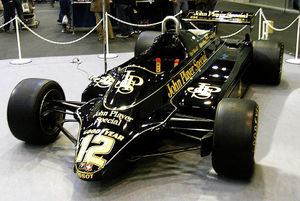Nigel Mansell
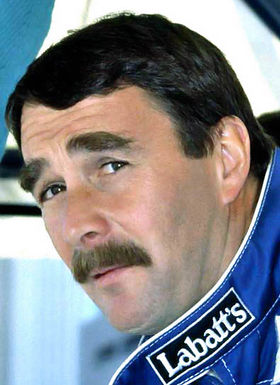
| |
| Nigel Mansell | |
|---|---|
| Nationality | |
| Years | 1980–1992, 1994–1995 |
| Team(s) | Lotus, Williams, Ferrari, McLaren |
| Races | 191 (187 starts) |
| Championships | 1 (1992) |
| Wins | 31 |
| Podiums | 59 |
| Points | 480 (482) Up until F1 1990, not all points scored by a driver contributed to their final World Championship tally (see list of pointscoring systems for more information). Numbers without parentheses are Championship points; numbers in parentheses are total points scored. |
| Poles | 32 |
| Fastest laps | 30 |
| First race | 1980 Austrian Grand Prix |
| First win | 1985 European Grand Prix |
| Last win | 1994 Australian Grand Prix |
| Last race | 1995 Spanish Grand Prix |
| Nigel Mansell Stats | |
| First year | CART, 1993 |
| Former teams | Newman/Haas Racing |
| Starts | 31 |
| Wins | 5 |
| Poles | 11 |
| Best finish | 1st |
| Year | 1993 |
| Prev series | Formula One |
| Prev series years | 1982-1992; 1994 |
| Titles | CART IndyCar World Series champion, CART Rookie of the Year |
| Title years | 1993 |
| Awards | Royal Automobile Club Gold Medal, ESPY for Best Driver |
| Award years | 1993 |
Nigel Ernest James Mansell OBE (born 8 August, 1953 in Upton-upon-Severn, Worcestershire) is a British racing driver from England who won both the Formula One World Championship (1992) and CART World Series (1993). Mansell was the reigning F1 champion when he moved over to CART, being the first person to win the CART title in his debut season, making him the only person in history to hold both titles simultaneously. During the early nineties, Mansell was commonly known, by the British media especially, as Our Nige.
His career in Formula One spanned 15 seasons, with his final two full seasons of top-level racing being spent in the CART series. Mansell remains the most successful British Formula One driver of all time in terms of race wins with 31 victories, and is fourth overall on the Formula One race winners list behind Michael Schumacher, Alain Prost, and Ayrton Senna. He was rated in the top 10 Formula One drivers of all time by longtime Formula One commentator Murray Walker. In 2008, American sports television network ESPN ranked him 24th on their top drivers of all-time.
Mansell raced in the GP Masters series and signed a one-off race deal for the Scuderia Ecosse GT race team to drive their number 63 Ferrari F430 GT2 car at Silverstone on 6 May 2007.
As of 2008, he is the most recent inductee to the International Motorsports Hall of Fame from a country other than the US, having been inducted in 2005.
He is the current President of one of the UK's largest Youth Work Charities, UK Youth.
Career
Born in Upton-upon-Severn, Worcestershire, Mansell spent 11 years of his early life as a Special Constable for Devon and Cornwall Constabulary. He had a fairly slow start to his racing career, using his own money to help work his way up the ranks. After considerable success in kart racing, he moved to the Formula Ford series to the disapproval of his father. In 1976, Mansell won 6 of the 9 races he took part in, including his debut event at Mallory Park. He entered 42 races the following year and won 33 to become the 1977 British Formula Ford champion, despite suffering a broken neck in a qualifying session at Brands Hatch. Doctors told him he had been perilously close to quadriplegia, that he would be confined for six months and would never drive again. Mansell discharged himself from the hospital and returned to racing. Three weeks before the accident he had resigned his job as an aerospace engineer, having previously sold most of his personal belongings to finance his foray into Formula Ford. Later that year he was given the chance to race a Lola T570 Formula 3 car at Silverstone. He finished fourth and decided that he was ready to move into the higher formula.
Mansell raced in Formula Three from 1978 - 1979. Mansell's first season in Formula Three started with a pole position and a 2nd place finish. However, the car was not competitive, as a commercial deal with Unipart required his team to use Triumph Dolomite engines that were vastly inferior to the Toyota engines used by the leading teams. After three 7th place finishes and a fourth in his last race, he parted from the team. The next season saw him take a paid drive with Dave Price Racing. Following a first win in the series at Silverstone in March, he went on to finish 8th in the championship. His racing was consistent, but a collision with Andrea de Cesaris resulted in a huge cartwheeling crash which he was lucky to survive. Again he was hospitalised, this time with broken vertebrae. His driving was noticed by Colin Chapman, owner of Lotus, and shortly after his accident, hiding the extent of his injury with painkillers, Mansell performed well enough in a tryout with Lotus to become a test driver for the Formula One team.
Formula One
1980-1984: Lotus
Mansell's skill as a test driver, including setting the fastest time around Silverstone in a Lotus car at the time, impressed Chapman enough to give him a trio of starts in F1 in 1980, driving a development version of the Lotus 81 used by the team, the Lotus 81B. In his Formula One debut at the 1980 Austrian Grand Prix, a fuel leak in the cockpit that developed shortly before the start of the race left him with painful first and second degree burns on his buttocks. Car failures forced him to retire from that race and his second, however an accident at his third event at Imola meant he failed to qualify. Team leader Mario Andretti wrote his car off before the final race of the season and Mansell had to give up his car for Andretti to compete in. Andretti announced he was leaving to move to Alfa-Romeo at the end of the season leaving Lotus with a vacant race seat.
Despite Mansell being unpopular with one of the team's backers, David Thieme, and much speculation in the press that Jean-Pierre Jarier would fill the vacancy, Chapman announced at the start of the season the seat would be filled by Mansell.
Mansell's four years as a full-time Lotus driver were a struggle, as the cars were unreliable. Out of 59 race starts with the team, he finished just 24 of them. He managed a best finish of third place which he obtained five times during the four years including in Lotus' fifth race of the 1981 season, and only the seventh of Mansell's Formula One career. Team mate Elio de Angelis took a surprise win at the 1982 Austrian Grand Prix, and was frequently faster than his less experienced colleague Mansell.
During the 1982 season, Mansell planned to race in the 24 Hours of Le Mans sportscar event in order to earn extra money. At the time Mansell was paid £50,000 a year and was offered £10,000 to take part in Le Mans. Chapman believed that by entering the Le Mans race, Mansell was exposing himself to unnecessary risk and paid him £10,000 to not take part in the race. Chapman extended Mansell's contract to the end of the 1984 season in a deal that made him a millionaire.
As a result of the gestures such as the above, Mansell became very close to Chapman and was devastated by his sudden death in 1982. In his autobiography Mansell stated that when Chapman died, "the bottom dropped out of my world. Part of me died with him. I had lost a member of my family". Following Chapman's death relationships at Lotus became strained, as replacement team manager Peter Warr did not have a high regard for him as a driver. Warr was not keen on honoring the last year of the contract that Mansell had signed with Chapman. However, with encouragement from Lotus' sponsors, John Player Special, it was announced Mansell would be staying with the team.
In 1984, Mansell finished in the championship top 10 for the first time, and took his first career pole. At the 1984 Monaco Grand Prix Mansell surprised many by overtaking Alain Prost in a wet race for the lead, but soon after retired from the race after getting off line and losing control on the slippery painted lines on the road surface. Mid-way through the season, the team's new managers signed Ayrton Senna for the following year, leaving Mansell with no race seat at Lotus. After receiving offers from Arrows and Williams, and firstly turning down Williams' offer, Mansell eventually signed for them.
Mansell was remembered by many this year when he collapsed while pushing his car to the finish line after the transmission failed on the last lap of the 1984 Dallas Grand Prix. The 1984 Grand Prix was the hottest on record, and after 2 hours of driving in 104°F (about 40°C) conditions Mansell fainted whilst pushing his car over the line to salvage a sixth place finish (and thus 1 championship point) in a race he had started from pole and led half of.
Mansell's final race with the Lotus team was heavily compromised due to Warr's unwillingness to give Mansell the brake pads he desired for the race. With 18 laps of the race remaining, and with Mansell in second position, the brakes on his car failed. On Mansell's departure, Warr was infamously quoted "He'll never win a Grand Prix as long as I have a hole in my arse".
1985-1988: Williams
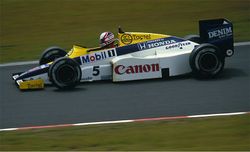
In 1985 Frank Williams snapped Mansell up to drive alongside Keke Rosberg as part of the Williams team, Mansell later saying "Keke was probably one of the best team-mates I've had in my career". Mansell was given the now famous "Red 5" number on his car, which he carried on subsequent Williams and Newman/Haas cars and which was brought to the public's attention mainly through commentator Murray Walker and his enthusiastic commentary for the BBC.
1985 initially appeared to provide more of the same for Mansell, although he was closer to the pace than before, especially as the Honda engines became more competitive by mid-season.
Mansell achieved second place at the Belgian Grand Prix at Spa-Francorchamps, and followed this with his first victory in 72 starts at the European Grand Prix at Brands Hatch in England. He achieved a second straight victory at the South African Grand Prix in Kyalami. These triumphs helped turn Mansell into a Formula One star.
Going into 1986, the Williams-Honda team had a car capable of winning on a regular basis and Mansell had established himself as a potential World Championship contender. He also had a new team-mate in Nelson Piquet. The Brazilian publicly described Mansell as "an uneducated blockhead" and had also criticised his wife, Roseanne. Unperturbed by Piquet's mind games, Mansell went on to record five Grand Prix wins in 1986 and also played part in one of the closest finishes in Formula One Grand Prix history, finishing second to Ayrton Senna in the Spanish Grand Prix at Jerez by a mere 0.014 seconds. The 1986 Formula One World Championship went right down-to-the-wire in Adelaide, Australia for the 1986 Australian Grand Prix with Prost, Piquet and Mansell all still in contention for the title. After aiming for a third place finish which would guarantee him the title, Mansell would narrowly miss out on winning it after his left-rear tyre exploded in spectacular fashion on the main straight with only 19 laps of the race to go. Mansell ended the season as runner-up to Alain Prost. His efforts in 1986 led to him being voted the BBC Sports Personality of the Year.
Six more wins followed in 1987, including an emotional and hugely popular victory at Silverstone in which he came back from 20 seconds behind in 20 laps to beat team-mate Piquet, with his car running out of fuel on the slowing down lap. However, at the Italian Grand Prix he missed a gear and let Piquet, who was using an active suspension car, through to win. A heavy qualifying accident at Suzuka in Japan for the penultimate race of the 1987 season severely injured Mansell's back (a spinal concussion), and as a result of Mansell missing the remaining two races, Piquet became champion for the third time even though he failed to score any points in these two remaining races.
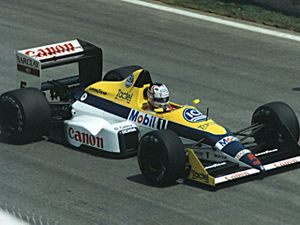
In 1988, Williams lost the turbo power of Honda to McLaren, and had to make do with a naturally-aspirated Judd engine. A dismal season followed, which saw Mansell's Williams team experiment with a terribly unreliable (but extremely innovative) active suspension system. Mansell would complete only two of the fourteen races in which he appeared in the 1988 season, both being podium finishes. Ironically, one of these was a second place at the British Grand Prix at Silverstone where the team had reverted to a passive suspension set-up.
Mansell developed chickenpox in the summer of 1988 and after a competitive (but ill-advised) drive in the very hot conditions of the 1988 Hungarian Grand Prix the condition became even worse, causing him to miss the next two Grands Prix.
1989-1990: Ferrari
In preparation for the 1989 season, Mansell became the last Ferrari driver to be personally selected by Enzo Ferrari before his death in August 1988, an honour Mansell described as "one of the greatest in my entire career". Enzo Ferrari presented a 1989 Ferrari F40 as a gift to Mansell. In Italy he became known as "il leone" ("the lion") by the tifosi (Ferrari fans) due to his fearless driving style. The season was one of change in the sport, with the banning of turbo engines by the FIA and the introduction of the electronic gearbox by Ferrari.
Mansell believed that 1989 would be a development year and that he would be able to challenge for the championship the following season. In his first appearance with the team he scored a very unlikely win in the Brazilian Grand Prix, his least favourite track and the home race of his bitter rival Piquet. He later jokedTemplate:Fact that he had booked aeroplane tickets home for halfway through the race as he predicted the car's new electronic gearbox would last only a few laps. Mansell became the very first driver to win a race in a car with a semi-automatic gearbox. He also remained the last man to win on his Ferrari debut until Kimi Räikkönen in the 2007 Australian Grand Prix.
The rest of 1989 was characterised by gearbox and various other problems which included a disqualification at the Canadian Grand Prix and a black-flagged incident at the Portuguese Grand Prix for reversing in the pit-lane, which resulted in a ban for the next race in Spain. However, Mansell finished fourth in the Championship with the help of a memorable second win for Ferrari at the Hungarian Grand Prix, where, after concentrating on the race set-up of his car, he won after a late-race pass on Ayrton Senna after starting 12th on the grid.
A tough 1990 followed with Ferrari, in which he had more reliability problems with the car, causing him to retire from seven races. In this season he was paired with Alain Prost, the reigning World Champion, who took over as the team's lead driver and played on Mansell's inferiority complex. Mansell recalls one incident where at the 1990 British Grand Prix, the car he drove didn't handle the same as in the previous race where he had taken pole position. On confronting the mechanics, it transpired that Prost saw Mansell as having a superior car and as a result, they were swapped without telling Mansell. After retiring from the race, he announced he was retiring from the sport altogether at the end of the season. Mansell obtained only a single win, at the 1990 Portuguese Grand Prix and finished 5th in the world championship. His retirement was cancelled when Frank Williams again stepped in. Williams signed Mansell on 1 October 1990 after Mansell ensured the contract stated that he would be the focus of the team, having experienced being the 'Number Two' driver at Ferrari. Mansell would be paid £4.6 million a season, a deal which made him the highest paid British sportsman at the time.
1991-1992: Williams
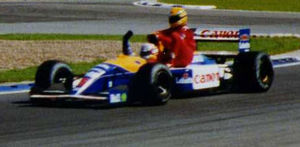
Mansell's return to Williams wasn't straightforward. Mansell would only agree to return if a list of demands were met, including undisputed number one status, guarantees of support in a wide variety of areas with each guarantee in writing, and assurances from suppliers such as Renault and Elf that they would do everything necessary to help him win. Frank Williams said the demands were 'impossible', Mansell concluded that if that were the case he would be happy to retire. Three weeks later the impossible had happened and Mansell was a Williams driver.
His second stint with Williams was even better than the first. Back in the familiar 'Red 5', he won five races in 1991, most memorably in the Spanish Grand Prix. In this race he went wheel to wheel with Ayrton Senna, with only centimetres to spare, at over 320 km/h on the main straight. Quite a different spectacle was offered following Mansell's victory in the British Grand Prix at Silverstone. Senna's car had come to a halt on the final lap, but, rather than leave his rival stranded out on the circuit, Mansell pulled over on his parade lap and allowed Senna to ride on the Williams side-pod back to the pits.
The Williams team's decision to develop their new semi-automatic gearbox by racing with it at the start of the season, was at the cost of points in the opening rounds of the championship. Senna was on 40 points by the time Mansell gained his first 6 in Monaco. Despite a good mid season, which included a hat-trick of victories, Senna's consistency (and Mansell's retirements at key races) meant that he finished second in the Championship once again, this time behind Senna.
1992 would be Mansell's finest season. He started the year with five straight victories (a record equalled by Michael Schumacher in 2004). At Monaco, the sixth race of the season, he took pole and dominated much of the race. However, with seven laps remaining, Mansell suffered a loose wheel nut and was forced into the pits, emerging behind Ayrton Senna's McLaren-Honda. Mansell, on fresh tyres, set a lap record almost two seconds quicker than Senna's and closed from 5.2 to 1.9 seconds in only two laps. The pair duelled around Monaco for the final four laps but Mansell could find no way past, finishing just two tenths of a second behind the Brazilian. Mansell was crowned Formula One Drivers' Champion early in the season at the Hungarian Grand Prix, where his second place finish clinched the Drivers' Championship, securing the title in the least number of Grands Prix since the 16-race season format started. This stood as a record until broken by Schumacher in 2002. Mansell also set the then-record for the most number of wins in one season (9) and highest number of pole positions (14).
He won the BBC Sports Personality of the Year award twice, in 1986 and 1992, one of only three people to do so.
CART IndyCar World Series
Despite being world champion, Mansell had a falling out with Williams. In his autobiography Mansell writes that this was because of a deal made at the previous Hungarian Grand Prix, which Williams reneged on, and the prospect of Frenchman Alain Prost joining the Renault-powered team.
Williams had neglected to tell Mansell that Prost had signed for 1993 at only the second race of the 1992 season in Mexico, a position that Mansell felt would be similar to their days together at Ferrari. To boot, Williams had Senna offering to drive the second car for free (although Senna found later he couldn't due to Prost having a clause in his contract allowing him to veto the move) and decided that there was little sense in paying the high fees Mansell went on to demand. With the original offer revoked Mansell, with no teams near the might of Williams, decided that enough was enough. An eleventh hour offer was made to Mansell at the Monza Grand Prix but by then the damage was done; Mansell retired from F1.
Mansell consequently left to join the Newman/Haas CART team in 1993. He took over the seat of Michael Andretti, who coincidentally had left CART to race in Formula One for McLaren. At the season opener at Surfers Paradise, Australia, he became the first "rookie" to take pole position and win his first race. A few weeks later however, he suffered a substantial crash at the Phoenix International Raceway, severely injuring his back. At the '93 Indianapolis 500, Mansell would lead the race only to finish third after losing the lead to Emerson Fittipaldi and Arie Luyendyk after a poor re-start. Later in the year however, Mansell would avenge his loss at Indianapolis to score a 500 mile race victory at Michigan, considered by many a tougher 500 mile race to win. Mansell would go on to score five wins for the 1993 CART season, which, with more high-placed finishes, was good enough to earn him the championship. This enabled Mansell to become the only driver in history to hold both the Formula One and CART championships at the same time because when he won the 1993 CART Championship, he was still 1992 F1 Champion as the 1993 F1 Championship hadn't been decided. Mansell's victory over Mario Andretti and other American drivers, coupled with 1991 CART champion Michael Andretti's failed sojourn into F1, was seen by many as evidence of superiority of non-US drivers.
Following this successful season in CART, Mansell received several awards including a Gold Medal from the Royal Automobile Club and the 1993 ESPY Award for Best Driver.
His Newman/Haas car was much less reliable the following year, 1994, and results suffered. It was during this season that Mansell "wore out his welcome" in the United States with glimpses of rude behavior, particularly after he was knocked out of the Indianapolis 500. After the crash, he stormed out of the track hospital, and refused medical care. When a reporter asked Mansell if he had spoken with Dennis Vitolo, the driver who had crashed into him, Mansell replied, "you speak to him." Subsequently, Mansell was set to sign autographs at a K-mart (the primary sponsor of his car), but due to a lack of demand, the event was cancelled. Mansell was also the catalyst for the breakdown in the relationship between himself and Mario Andretti. Mario has since remarked "I guess if Ronnie Peterson was the best team-mate I ever had, Nigel Mansell was the worst" and "I had a lot of respect for him as a driver, but not as a man".
Return to Formula One
In 1994 Mansell made a Formula One comeback. After the untimely death of Ayrton Senna, he returned to Formula One with Williams replacing rookie David Coulthard for the French Grand Prix and the last three races of the season. Mansell was paid approximately £900,000 per race, compared to Williams' lead driver at the time, Damon Hill being paid £300,000 for the entire season. Mansell's return was helped by Bernie Ecclestone helping unravel his contracts in the United States. It was important for F1 to have a world champion driving that season and they needed Mansell. Mansell wasn't as quick as Damon Hill in race trim but signs that his speed were coming back were evident in Japan during a fantastic battle with the Ferrari of Jean Alesi. Mansell took his final Grand Prix victory, the Australian Grand Prix, which was the final race of the season having out-qualified the two contenders for the title, Damon Hill and Michael Schumacher, in the process. The plan was initially for Mansell to protect Hill from Schumacher, but both drivers passed him at the start and eventually collided, handing Schumacher his 1st World Title.
Williams had an option on Mansell's services for 1995 which Mansell was sure they would take. However, Williams opted for youth over experience and hired Coulthard.
1995: McLaren
Mansell was quick again and on the back of winning two titles, he was still hot property. After losing the Williams seat to David Coulthard, Mansell signed to drive for McLaren in 1995.
It was well documented that Mansell and Ron Dennis never saw eye to eye but with McLaren's sponsors wanting a world champion, Dennis had only two options, the second option, Schumacher, was already taken which left Mansell. Media speculated from the start that they wouldn't last together due to the two contrasting personalities.
The season didn't start at all well, Mansell couldn't fit into the car and wasn't able to race until Imola where he ran in the middle of the field a good way off the pace of his team-mate Mika Häkkinen. The 1995 McLaren understeered heavily. Mansell's driving style relied on a car not suffering from understeer so that he could brake and turn in to the corner whilst braking, but the McLaren simply wouldn't do that. A second race came with a similar outcome but outpaced and frustrated with his car's handling characteristics, he chose to retire after just two races with the team. Mansell cited the decision to retire as him not wanting to make up the numbers and with no hope of the McLaren being competitive.
A few testing sessions with F1 teams including Jordan suggested another comeback could be on the cards but it never happened.
British Touring Car Championship
Mansell made a return to racing in 1998 in the British Touring Car Championship, driving in a Ford Mondeo for three rounds. As it was, the Ford was highly uncompetitive - the manufacturer finished the season 7th out of 8 in the championship. With the number 5 already taken by James Thompson, Mansell raced with the red number 55.
At his first event at Donington Park, he retired 3 laps into the sprint race, meaning he would start the feature race in 19th position on the grid. As the conditions changed and the track got wetter, Mansell found himself leading the race for several laps and he finished in 5th position. The race was regarded by many fans as one of the greatest in touring car history.
It was to be his best finish in the series, as he failed to finish either race at the next round he participated in at Brands Hatch, and at his final race at Silverstone he finished in 14th and 11th place. Having competed in 3 of the 13 rounds, he finished 18th out of 21 in the drivers championship.
Subsequent appearances
On July 16, 2005, Mansell took part in a Race of Legends exhibition event at the Norisring round of the DTM. He competed against Jody Scheckter, Alain Prost, Mick Doohan, Emerson Fittipaldi and Johnny Cecotto, each driver having an opportunity to drive the Audi, Mercedes and Opel offerings. Prost was announced as the winner by the DTM organisers.
Mansell became a financial stakeholder and a driver in the new Grand Prix Masters series. Following a period of testing and developing the car, Mansell made a successful race comeback by winning the inaugural race of the series in Kyalami in November 2005.
After the success of the race at Kyalami, four dates were scheduled for the GP Masters Series in 2006, including one at Silverstone. Mansell won the season opener at Qatar in April 2006 from pole position. The Monza round of the series was cancelled due to noise limitations at the venue, whilst technical issues quickly ruled him out of the Silverstone race.
He also made a comeback to Brands Hatch, scene of his first Grand Prix win, in May 2006, driving some demonstration laps in the BMW M3 GTR that Andy Priaulx drove to victory in the 2005 24 Hours Nürburgring, as part of the World Touring Car Championship event.
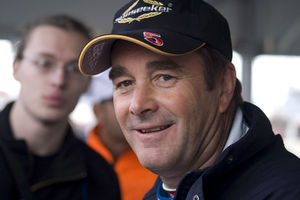
On the weekend of May 6, 2007 he made an appearance in the second round of the FIA GT championship at Silverstone driving a Ferrari 430 GT2 for the Scuderia Ecosse team. He was paired with Chris Niarchos finishing 7th in class and 21st overall.
Mansell, with his son Leo, tested a Chamberlain-Synergy team Le Mans prototype Lola-AER B06/10 during the week commencing 14 July 2008 at the Estoril circuit and the pair were said to be considering a drive in the American Le Mans series, possibly commencing as soon as October 2008 in the Petit Le Mans event, although neither driver was in the final field.
On July 3, 2009, Mansell tested other son Greg's World Series by Renault car at the Silverstone circuit, setting a best time six seconds off the pace of the fastest driver in the test session.
On August 19th, 2009, it was announced that Mansell would be taking part in the last round of the 2009 Le Mans Series, the 1000km of Silverstone, driving Team LNT's Ginetta-Zytek GZ09 alongside his son Greg and team boss Lawrence Tomlinson.
Endorsements
On October 1st, 2009 Nigel appeared as the 'Face of Euronics'
Awards
Mansell was awarded the title of BBC Sports Personality of the Year in both 1986 and 1992. Only two other people have won the award twice, one of which being fellow racing driver and former F1 World Champion Damon Hill. Mansell was inducted into the International Motorsports Hall of Fame in 2005.
Racing career results
Formula One World Championship results
(key) (Races in bold indicate pole position, races in italics indicate fastest lap)
American Open-Wheel racing results
CART
(key) (Races in bold indicate pole position)
| Year | Team | Chassis | Engine | 1 | 2 | 3 | 4 | 5 | 6 | 7 | 8 | 9 | 10 | 11 | 12 | 13 | 14 | 15 | 16 | Rank | Points |
|---|---|---|---|---|---|---|---|---|---|---|---|---|---|---|---|---|---|---|---|---|---|
| 1993 | Kmart Texaco Newman/Haas Racing | Lola T9300 | Ford Cosworth XB | SUF 1 |
PHX INJ |
LBH 3 |
IND 3 |
DET 15 |
MIL 1 |
POR 2 |
CLE 3 |
TOR Ret |
MIC 1 |
NWH 1 |
ROA 2 |
VAN 6 |
MDO 12 |
NAZ 1 |
LAG 23 |
1st | 191 |
| 1994 | Kmart Texaco Newman/Haas Racing | Lola T9400 | Ford Cosworth XB | SUF 9 |
PHX 3 |
LBH 2 |
IND Ret |
MIL 5 |
DET Ret |
POR 5 |
CLE 2 |
TOR Ret |
MIC 26 |
MDO 7 |
NWH Ret |
ROA 13 |
VAN 10 |
NAZ Ret |
LAG 8 |
8th | 88 |
Complete Grand Prix Masters results
(key)
| Year | Team | 1 | 2 | 3 | 4 |
|---|---|---|---|---|---|
| 2005 | Team Altech | RSA 1 |
|||
| 2006 | Team Altech | QAT 1 |
ITA C |
GBR Ret |
RSA C |
| 2007 | Team Altech | ROM C |
QAT C |
RSA C |
References
- Hamilton, Maurice Frank Williams Macmillan ISBN 0-333-71716-3
- Mansell, Nigel My Autobiography Collins Willow ISBN 0-00-218497-4
- BTCC Pages
- Crash.net
External links
- Nigel Mansell official website
- Profile - by FIA GT Championship official website
- King Nigel Mansell - Unofficial site
- Biography of Nigel Mansell
- BBC Sport - News of Return in Grand Prix Masters
- Grand Prix Masters
- Nigel Mansell statistics
- Nigel Mansell Videos
- Grand Prix History - Hall of Fame, Nigel Mansell
- Nigel Mansell Lotus 87
